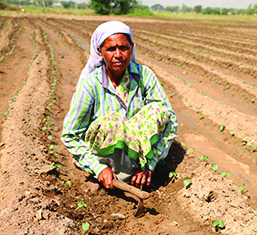To learn more about Digital Green’s AI-powered platform and how it impacts small-scale farmers in India, Ethiopia, Kenya, Nigeria and Nepal, we encourage you to sign up for our newsletter.
NPM as a route to self-sufficiency and quality produce for small farmers

48 year-old Chintakayala Devamma, is a small but progressive farmer from Podaralla village, Anantapur district, Andhra Pradesh.
When we visited her on her field, Devamma and her son and daughter-in-law were harvesting okra. Devamma proudly gestured towards the half grown castor trees on the border of her farm. Instead of fencing our field with twigs and bamboo, we have planted castor trees around our field. Castor trees have very big leaves. The pests and insects that would generally attack the crop will make a shelter on those leaves and eat them out and spare the crop. Depending on intensity of pests, we spray NPM kashayams (bio-extracts) like neemastram (neem kernel extract) and Brahamastram (bio-extract for pest control) to kill the pests. Eventually, incidence of pests and insects on the main crop will reduce to a great extent. This makes Castor tree a good border crop, shared Devamma.

We also make an additional income by selling Castor seeds. This was the first practice that I adopted after attending a training program on sustainable non-pesticide management (NPM) organized by the farm wing of Society for Elimination of Rural Poverty (SERP) – Community Managed Sustainable Agriculture (CMSA), she added.

Looking at Devammas keen interest and her articulation skills, Bukkaraya Samudram revenue block self-help groups federation selected her as one of the Sub-Committee members in non-pesticide management division. As part of this job, she attended trainings on NPM, visited several farms, and interacted with scores of farmers to encourage them to adopt NPM practices. Being a member in Maheshwari self-help group (SHG) has benefitted my family in many ways. Apart from financial support, we were shown videos on NPM practices. With that exposure, being a Sub-committee member, I have trained many other farmers on adopting NPM practices, shared Devamma.
Devammas story also reinforces the power of peer-to-peer learning. Initially, the SERP-CMSA trainings and Digital Green videos helped her learn the NPM practices, and then she started practicing them herself. This lent credibility to NPM among her peers. We have all NPM practices adopted on our one and a half acres of land, shaed Devamma proudly pointing to a corner of her field where she had created a Nadep compost pit. She explained that she had used the compost created there recently for transplanting the latest crop of okra, which too she points out.
When people come to work in my field, they see all of it. When we sit together for lunch, we share our food. I share curries made of vegetables from my field. They instantly recognise that they taste deliciously different. That convinces them of the relevance of NPM, she adds.

Many farmers in and around Bukkaraya Samudram block cultivate vegetables to supply to Bengaluru and Hyderabad, the nearest metros. Vegetables often get some disease or other And the farmers spend a large amount of money on pesticides and fertilizers. Especially with vegetables like okra that have relatively short crop cycles, the use of pesticides and fertilizers is concentrated over a period of time and result in high toxicity of soil and crop. Our cluster activist showed us videos on the use of sour butter milk, neemastram (neem-kernal extract), and ghanajeevamrutham (bio-fertilizer) etc. After watching the video on sour-butter milk and its advantages, we adopted that practice. It really helped to cure the powdery mildew disease, shared Devamma. Before watching the Digital Green video, we had never known about the use of sour butter milk for pest control, added Devamma.
When asked whether her family has any debts, Devamma shares proudly that they didnt have any. In fact, she says they have a surplus of INR 30,000 in hand. When our farm investments have reduced so much, there is no question of borrowing money from others. We grow everything that we consume, she said showing us a small patch of land where she has sown onions, tomatoes, and drumsticks etc.
Anantapur, one of the most arid and drought affected districts in India, is often in the news due to high levels of agrarian distress. Despite being from the same district, Devammas story is different. My family depends solely on this small piece of land. We spend most of our time on the field. Cultivating vegetables gives us a regular income. As part of crop rotation, we also cultivate groundnut and tomato. By the time we finish harvesting the current okra crop, the next crop is ready to be harvested shared Devamma. Though she is a small farmer, her family is food secure and ensured a moderate income. Stories like Devammas may not be a panacea for larger agricultural concerns.

Pro-farmer policies, price guarantee, and stable markets are what make farmers lives easier. But, certainly, stories like Devammas may stand as an alternative in the midst of agricultural distress until we find a longer-term solution. As I walked back from her field, I was convinced that its this spirit of small farmers which needs to be celebrated and shared with the wider audiences again and again.
(The author of this case study wishes to acknowledge support from District Project Management Unit, SERP-CMSA, Anantapur, A.P., K.Masthan Vali, Assistant Program Manager, Digital Green)